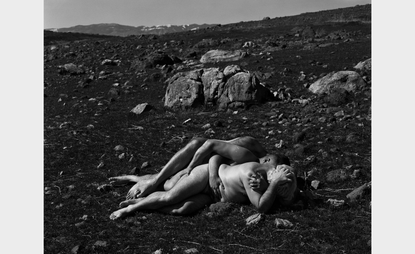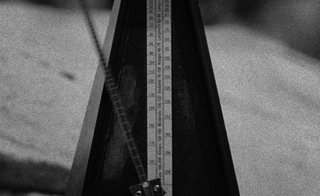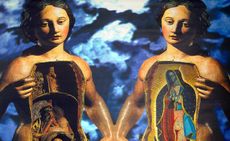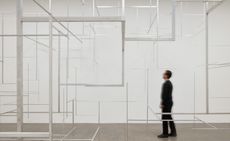Mark Armijo McKnight’s bodily landscapes capture the tactile serenity of the American West
The artist’s new exhibition at the Whitney Museum, which is organised by the museum curator Drew Sawyer, offers a succinct window into his contemplative suggestion of queering a landscape

The land and the body inhabit Mark Armijo McKnight’s black and white photographs with a mystic alchemy. Visually, the two are intertwined: a torso, for example, is impossible to distinguish from a dune, or the clouds, from the cigarette smoke puffed out of a mouth. The New York-based artist, however, is strongly invested in the emotional chemistry of two forms of tactility. This meditative harmony of the earth and the skin meanders throughout McKnight’s new exhibition, Decreation, at The Whitney Museum where nudes seep into the American west panorama. 'The landscape is a site of catharsis and meaning-making, and the earth is the protagonist,' McKnight tells Wallpaper* about his pictures. He believes in the 'psychological dimension,' of an either barren or lush landscape, 'which wouldn’t otherwise be in an image.'

Mark Armijo McKnight, The Black Place (ii), 2024
Somnia (2023) frames three nude men caressing each other amidst a rocky scenery—their limbs tightly envelop their bulky bodies, not unlike the rocks peppered around them with a hefty and serene bulbousness. Their virile intimacy sinks into the fallow land, with soft skin rubbing into the rough flora. The Black Place (2024) initially tricks the eye with the suggestion of a human likeness; however, the image exclusively captures a piece of rutted earth, uninhibited yet soulful. 'Composed or even a bit claustrophobic' quality of his images stems from a desire to 'make the viewer feel inside a place,' the artist explains which emphasises the 'ethos of a landscape out of a deep respect for the natural world.'

Mark Armijo McKnight, Clouds (Decreation), 2024
Besides the familiar territory of photography, McKnight dips his toe into two new mediums for his first institutional outing in New York. An eleven-minute long black and white film, titled Without a Song (2024), is a moody contemplation on time and light under the sharp desert light. In it, a suite of metronomes are perched across a wash of rocks, while their rapid ticking permeates into the gallery with the puncturing immediacy of bullet sounds.
The show’s five photographs are also joined by two blocky limestone sculptures that moonlight as seats for the film’s audience. Together titled Duet (2024), the geometric forms with abrupt carvings each weigh around 5,600 pounds. They hold a “monolithic feel,” according to the artist who based the sculptures on ancient scratch dials. Their original purpose of informing people about when to pray before the invention of the clock resonates with temporality inside the museum’s contemporary confines.
'They were called scratch dials because the dials were carved so crudely into the surface of a stone,' adds McKnight. Similar to the film’s lingering hold on time, the sculptures solidify fluidity which is both linear and circular, akin to time’s passing. 'The desperation to mark time is both beautiful and relatable,' muses McKnight who finds a similar urge in his lens. 'What is photography but a confluence of time, light, and shadow?' he asks. The duo of sculptures in this sense reflects his 'distillation of elemental concerns about taking pictures.'

Mark Armijo McKnight, Without a Song (solo ii) , 2024
The black and white palette allows the artist to paint his images with swatches of dimness and rely on the poetic intrigue of mystery. 'I can bury things in shadows and have more control than I would in colour,' says McKnight. He thrives in making 'more subjective decisions,' unburdened by creating realistic or believable pictures. 'The affective potential of black and white images allow for a tonal mode and rhythmic coherence to create a metaphor,' he adds.
Mark Armijo McKnight: Decreation is open at the Whitney Museum of American Art through January 5, 2025
Wallpaper* Newsletter
Receive our daily digest of inspiration, escapism and design stories from around the world direct to your inbox.
Osman Can Yerebakan is a New York-based art and culture writer. Besides Wallpaper*, his writing has appeared in the Financial Times, GQ UK, The Guardian, Artforum, BOMB, Airmail and numerous other publications. He is in the curatorial committee of the upcoming edition of Future Fair. He was the art and style editor of Forbes 30 Under 30, 2024.
-
 Lego opens its first Superpower Studios at Paris’ La Gaîté Lyrique
Lego opens its first Superpower Studios at Paris’ La Gaîté LyriqueIn collaboration with Lego’s new Global Play Ambassadors, artists Aurélia Durand, Chen Fenwan and Ekow Nimako, and overseen by Colette co-founder Sarah Andelman, Paris is the site of the first Lego Superpower Studios
By Jonathan Bell Published
-
 ‘If kids grew up going to London Design Festival they would learn so much’: architect Shawn Adams
‘If kids grew up going to London Design Festival they would learn so much’: architect Shawn AdamsIn the first of our interviews with key figures lighting up the London Design Festival 2024, Shawn Adams, founder of POoR Collective, discusses the power of such events to encourage social change
By Ali Morris Published
-
 Discover London’s lesser-known design gems with ‘an opinionated guide’
Discover London’s lesser-known design gems with ‘an opinionated guide’‘An opinionated guide to Design London’ by Sujata Burman and Wallpaper’s Rosa Bertoli is a carefully curated tour of intriguing design spots across the capital
By Tianna Williams Published
-
 Dark, glamorous and hedonistic: a photography book captures New York in the 1990s
Dark, glamorous and hedonistic: a photography book captures New York in the 1990sNew York: High Life, Low Life, by Dafydd Jones, goes behind the scenes of New York society
By Hannah Silver Published
-
 Derrick Alexis Coard’s portraits are a sensitive, positive testimony to Black men
Derrick Alexis Coard’s portraits are a sensitive, positive testimony to Black menThe late artist Derrick Alexis Coard’s retrospective ‘I Am That I Am’, at New York’s Salon 94, honours his ‘symbolic expression for possible change for the African-American male community’
By Tianna Williams Published
-
 Nona Faustine confronts the past in New York
Nona Faustine confronts the past in New YorkArtist Nona Faustine reframes New York's colonial past in an exhibition at the Brooklyn Museum
By Hannah Silver Published
-
 Casa Bosques’ queer-themed book curation comes to New York’s East Village
Casa Bosques’ queer-themed book curation comes to New York’s East VillageIn Pride Month 2024, Casa Bosques’ pop-up bookstore in The Standard hotel, East Village, offers a stylish haven for literary mavens
By Hannah Silver Published
-
 ‘Very few museums were interested in my work until recently’: Amalia Mesa-Bains on her first-ever retrospective
‘Very few museums were interested in my work until recently’: Amalia Mesa-Bains on her first-ever retrospective‘Amalia Mesa-Bains: Archaeology of Memory’ is a long-overdue exhibition at El Museo del Barrio in New York celebrating five decades of the trailblazing Chicanx artist
By Sofia de la Cruz Published
-
 Frieze New York 2024: what to see in and around the city
Frieze New York 2024: what to see in and around the cityFrieze New York 2024 (until Sunday 5 May) sees the city’s ample spring season programming celebrated at The Shed
By Osman Can Yerebakan Published
-
 Calling NYC grads! Sarabande Foundation invites you to an industry masterclass to pave way into the creative world
Calling NYC grads! Sarabande Foundation invites you to an industry masterclass to pave way into the creative world‘What Now?’ by Sarabande Foundation is a post-college guide to support graduates in making their next steps, with advice from the likes of Burberry, Thom Browne, and more
By Tianna Williams Published
-
 ‘I don't know what art is, but we have to make these things to understand ourselves’: Antony Gormley in New York
‘I don't know what art is, but we have to make these things to understand ourselves’: Antony Gormley in New YorkWallpaper* meets Antony Gormley as his new exhibition, ‘Aerial’ opens at White Cube New York
By Hannah Silver Published